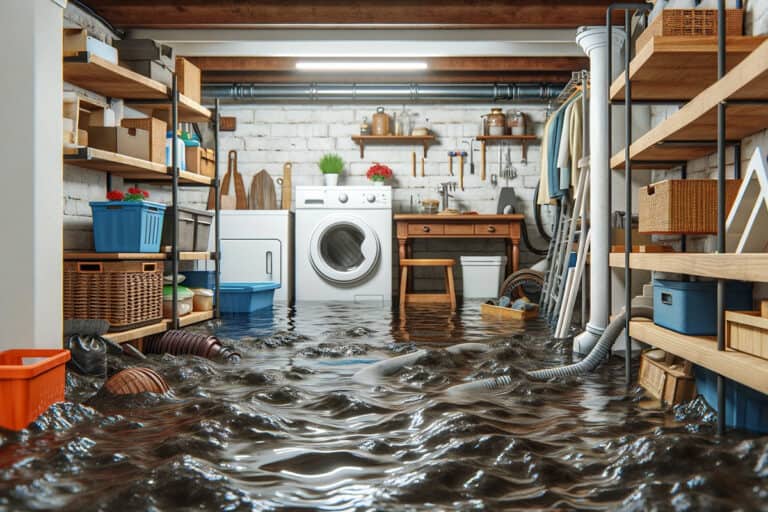Disclosure: I am compensated for purchases made through some links on this site. Click for details.
Determining if homeowners insurance covers mold removal is crucial, as mold can be a common yet potentially hazardous issue within homes. Mold removal coverage typically hinges on the origin of the mold; if it’s a byproduct of a covered peril outlined in the insurance policy, such as water damage from a burst pipe, the policy may provide coverage. Nevertheless, standard policies often have limitations or exclusions, particularly concerning mold caused by flooding, negligence, or normal wear and tear.
Insurance claims for mold remediation can be complex due to the specifics of each situation and the varied policy terms among insurance providers. If mold damage is directly tied to a covered peril, homeowners are typically more successful in filing a claim. For damage resulting from incidents like floods, separate flood insurance would be necessary to address mold remediation, as most standard homeowners policies exclude flood damage.
Key Takeaways
- Homeowners insurance may cover mold removal if the mold results from a covered peril.
- Mold damage due to flooding, negligence, or wear and tear is often excluded from standard policies.
- Specific flood insurance is required to cover mold remediation after a flood, as it’s not included in basic homeowners policies.
Understanding Homeowners Insurance Coverage
When examining homeowners insurance from a coverage standpoint, it is essential to discern what incidents are covered, how negligence affects claims, and the inherent limitations and exclusions that come with mold damage.
Covered Perils and Mold Damage
Most homeowners insurance policies define covered perils as specific, sudden events causing damage to your home that were not predictable. For instance, mold caused by a burst pipe is typically covered because it is abrupt and accidental. Contrastingly, mold that arises over time because of humidity or unnoticed leaks tends to fall outside the scope of standard coverage.
Neglect vs. Sudden Incidents
Insurance providers draw a distinct line between damage stemming from negligence and that from sudden, uncontrollable incidents. A policyholder’s failure to maintain their home, resulting in mold-related damage, is often not covered. On the flip side, if mold develops quickly due to a covered peril such as a storm that damages the roof and allows water in, then remediation is more likely to be included in the policy.
Limitations and Exclusions
The specifics of what each homeowners insurance policy will cover can vary greatly. Policies generally state limitations on the amount they’ll pay for mold damage, frequently capping between $1,000 and $10,000. Moreover, some cases of mold-related damage require an additional rider or special add-on to the homeowner’s policy for the damage to qualify for coverage.
Common Sources of Mold in the Home
Mold thrives in moist environments and can often be found in areas of the home where water damage or persistent dampness occurs. Identifying the common sources of mold can assist homeowners in mold prevention and management.
Water Damage and Flooding
Water damage and flooding can create the perfect conditions for mold growth, particularly in the basement where pooled water can go unnoticed. When a home experiences flooding, whether from external sources or internal failures, the excess moisture can seep into walls, carpets, wood, and other materials, encouraging mold to form.
Persistent Dampness and Leaks
Areas with ongoing exposure to moisture, such as around kitchen sinks or in bathrooms, can foster mold development. Homes often encounter water leaks from pipes or roofs, and if left unrepaired, these leaks provide a constant source of moisture that is ideal for mold proliferation.
Appliances and Water Heater Issues
Household appliances that use water, like dishwashers and washing machines, can develop leaks or suffer from condensation. Problems with a home’s water heater can also lead to leaks or spills, often occurring in less-frequented areas such as a utility closet, which allows mold to establish and spread unnoticed.
Mold Remediation and Removal
Mold remediation is a process for effectively removing and cleaning up mold infestations in residential or commercial properties. It typically involves assessing the extent of mold damage, containing the area, and employing various methods to remove the mold while preventing future growth.
Professional Mold Removal Services
Professional mold removal services offer the expertise required for thorough mold remediation. These specialists have access to industrial-grade equipment like high-efficiency particulate air (HEPA) vacuums and commercial-grade dehumidifiers that ensure the mold is contained and removed effectively. They are trained to handle different types of mold, including black mold, which can be particularly dangerous.
DIY Mold Remediation
For minor mold issues, some homeowners may opt for DIY mold remediation. This process can involve cleaning surfaces with mold-killing solutions, drying out rooms using fans and dehumidifiers, and making necessary repairs to water-damaged areas. However, if a person is dealing with extensive mold over a large area or black mold, it is advised to seek professional assistance due to health risks and the complexity of remediation.
Preventative Measures
Preventative measures are essential to avoid mold problems before they require significant removal efforts. Keeping indoor humidity levels low with a dehumidifier, repairing leaks promptly, and ensuring proper ventilation can help prevent mold growth. Regular inspection and cleaning of areas prone to moisture, such as bathrooms and basements, can help mitigate the need for future mold remediation and rug or carpet replacement due to mold damage.
Insurance Claims for Mold Removal
When mold infestations occur, homeowners may be faced with expensive remediation costs. It’s essential to understand how to navigate filing a mold insurance claim and know the intricacies of your homeowners insurance policy in relation to mold damage.
Filing a Mold Claim
A mold claim can often be filed if the mold results from a covered peril, such as water damage from a burst pipe. Homeowners should promptly notify their insurance provider to begin the claim process. They must provide evidence that the mold was a consequence of an incident covered under their homeowners insurance policy.
Documenting Mold Damage
To substantiate a mold insurance claim, documenting the damage is crucial. Homeowners should photograph the affected areas and keep detailed records of any signs of mold growth. It’s important to include dates, times, and the extent of the mold to establish a strong foundation for the insurance claim. These documents serve as proof that the mold is directly tied to a covered event in the policy.
Understanding the Claims Process
Navigating the claims process for mold removal can be complex, as coverage varies by insurer and specific policy details. Insurers generally require that the mold be caused by a “sudden and accidental” covered event. The claim amount may also be subject to policy limits or special deductibles as outlined by your homeowners insurance policy. Knowing these limits ahead of time can help set realistic expectations for potential coverage.
Flood Insurance and Mold Coverage
Understanding the specifics of when flood insurance provides coverage for mold damage is critical for homeowners, as flood-related mold can lead to significant repair costs.
When Does Flood Insurance Apply?
Flood insurance applies to damage caused directly by flooding, which must be from an external source, typically defined as an overflow of inland or tidal waters, unusual and rapid accumulation or runoff of surface waters, or mudflow. For instance, if a homeowner’s property is damaged due to heavy rains causing a nearby river to overflow, their flood insurance policy may come into effect.
Mold Damage After Flooding
Flood insurance does not typically cover mold damage if the homeowner fails to take action to prevent the mold from developing after a flood. However, if the policyholder can demonstrate that mold damage occurred as an immediate result of a flood and that they took appropriate measures to mitigate the spread of mold, their policy may cover the repairs. This coverage can be complex, as there are stipulations regarding the timeliness and diligence of the homeowner’s response to initial flood damage.
Addressing Common Questions and Concerns
When it comes to homeowners insurance, the specifics of coverage for mold removal can spark many questions. This section will provide clear, confident answers to common concerns regarding mold damage and insurance coverage.
Will My Policy Cover Mold from a Leaking Window?
Homeowners insurance policies may cover mold damage if the mold is a result of a “covered peril” such as sudden and accidental damage. For instance, mold that develops due to a leaking window resulting from a storm may be covered. Homeowners need to contact their insurance provider to verify coverage specifics, as policies can vary greatly.
How to Address Mold from Fire Extinguishing Efforts?
Mold resulting from extinguishing a fire can be complex when it comes to insurance coverage. Typically, if the need for fire extinguishing efforts falls under a covered event and subsequently causes dampness leading to mold, the policyholder may receive assistance for mold remediation. Policyholders are advised to review the details of their coverage concerning mold stemming from fire response actions.
Handling Hidden Water Damage Coverage
Coverage for hidden water damage can be particularly tricky. Insurance often covers mold damage if it originates from a covered risk that was not apparent or hidden over time, like a pipe leaking inside a wall. However, regular maintenance to prevent such occurrences, such as cleaning gutters to prevent water seepage, is also expected from the homeowner for eligibility of coverage.
Additional Resources and Expert Advice
When seeking clarity on whether homeowners insurance covers mold removal, homeowners should consider consulting Policygenius and engaging directly with insurance representatives. These resources offer expertise and personalized guidance to help interpret policy details and coverage limits.
Consulting with Policygenius
Policygenius provides an accessible platform where individuals can compare insurance policies and receive expert advice. Qualified advisors can assist homeowners in understanding what their current policy covers regarding mold damage and what additional coverage may be necessary. They break down the complexities of insurance policies, ensuring that individuals make informed decisions about their coverage.
Contacting Insurance Representatives
Insurance company representatives are available to address specific concerns related to mold coverage. Homeowners are encouraged to contact their insurance provider to obtain definitive explanations of what their policy entails. Representatives can explain the conditions under which mold remediation is covered and guide homeowners through the claims process if they are eligible. Homeowners should document their communications and maintain records of all interactions with their insurance company.
Conclusion: Navigating Mold Removal and Insurance Coverage
Dealing with mold in your home can be a daunting task, requiring a careful balance between immediate remediation efforts and navigating the complexities of insurance coverage. Understanding the intricacies of homeowners insurance in relation to mold removal is crucial for effectively managing this challenge. Below, we summarize key takeaways and strategies to ensure you’re well-equipped to tackle mold issues and insurance claims.
Key Takeaways
- Insurance Coverage for Mold Removal: Homeowners insurance may cover mold removal if the cause is a covered peril, such as water damage from a burst pipe. However, coverage often excludes mold resulting from flooding, negligence, or wear and tear.
- Claim Filing Tips: Promptly notifying your insurance provider and providing detailed documentation of the mold damage are critical steps in the claim process. This documentation should ideally include photographs, dates, and a comprehensive account of the damage.
- Preventative Measures: Proactively managing moisture in your home, through the use of dehumidifiers, timely repairs of leaks, and ensuring proper ventilation, can significantly reduce the risk of mold growth.
- Professional vs. DIY Remediation: While minor mold issues may be manageable on your own, professional remediation is recommended for extensive mold damage, particularly for dangerous types like black mold.
Table: Strategic Approach
| Aspect | Strategy |
|---|---|
| Insurance Navigation | Engage with insurance professionals and utilize resources like Policygenius to understand your coverage limits and exclusions. |
| Mold Remediation | Determine the extent of mold damage to decide between DIY efforts or hiring professional services. |
| Prevention | Implement regular inspections and maintenance to minimize moisture and prevent mold growth. |
Table: Mold Remediation and Insurance Claims Process
| Process Step | Description |
|---|---|
| 1. Identify Mold Source | Inspect your home for mold and identify potential moisture sources. |
| 2. Document Damage | Take detailed photographs and notes on the extent and location of mold damage. |
| 3. Review Insurance Policy | Check your homeowners insurance policy for mold coverage and any applicable exclusions. |
| 4. File a Claim (if applicable) | Notify your insurance provider and submit necessary documentation to start the claim process. |
| 5. Remediation and Repair | Depending on the severity, engage in DIY remediation or hire professionals for mold removal. |
| 6. Prevent Future Mold Growth | Take steps to reduce humidity, fix leaks, and improve ventilation to prevent recurrence. |
Optimizing Your Approach
To effectively manage mold removal and insurance claims:
- Prioritize safety and health by addressing mold issues promptly.
- Understand your insurance policy in-depth, focusing on the specifics of mold coverage.
- Seek professional advice when necessary to navigate complex claims and remediation efforts.
By adhering to these guidelines and strategies, homeowners can navigate the challenges of mold removal and insurance coverage more confidently and effectively. Remember, the key to successful mold management lies in prevention, prompt action, and leveraging the right resources to understand and maximize your insurance benefits.




